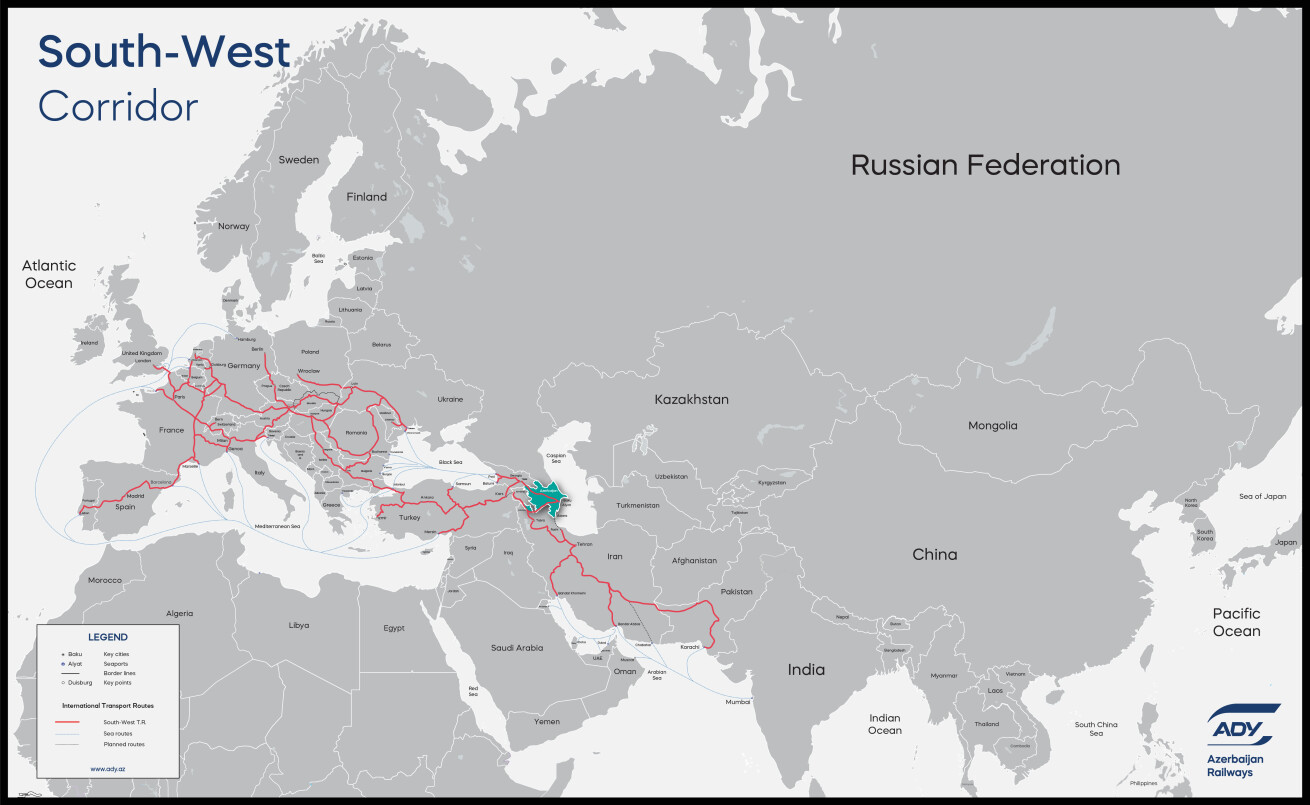South-West Transport Corridor

South-West Transport Corridor
The corridor was established in early 2016. The South-West Transport Corridor operates along the geographical route of the Persian Gulf/India – Iran – Azerbaijan – Georgia – Ukraine – Europe (or Turkey – Europe). The corridor was initiated by "Azerbaijan Railways" (ADY) CJSC. The route was introduced on January 12, 2016, in Baku. During the event, discussions were held between the railway and seaport enterprises of Azerbaijan, Georgia, Iran, and Ukraine, and a protocol on the development of the corridor was signed. According to this document, the full name of the corridor was defined as the "Persian Gulf – Iranian Astara and Caspian Sea – Black Sea – Europe."
The prospects of extending cargo transportation along the Mumbai – Bandar Abbas – Qazvin – Astara (Iran) – Astara (Azerbaijan) – Poti/Batumi route to the ports of Ukraine (Odessa – Illichivsk), Romania (Constanta), and Bulgaria (Burgas) were discussed, and initial tariffs for the routes were determined.
The main advantage of the South-West corridor over other alternative routes (especially sea routes through the Suez Canal) is that the transit distance and time are reduced by approximately three times. For instance, while transportation by sea from the Persian Gulf and India to Europe ("oceanic freight") takes about 35-37 days, it is projected that this duration will be reduced to 10-12 days along the South-West corridor.
This corridor, passing through the territories of Iran, Azerbaijan, Georgia, and Ukraine, reduces transit times for transporting goods from India (mainly from the seaports of Mumbai and Nava Sheva) to Europe (Rotterdam, the Baltic Sea, Northern Europe, Russia) and vice versa. The creation of the South-West corridor will provide new opportunities for the safe, fast transportation of goods with a unified pricing policy.
The South-West cargo transportation route is designed to handle a portion of the trade turnover between EU countries and Ukraine, and India, Iran, and the Persian Gulf countries. The development of the South-West corridor opens up opportunities for increasing Iran’s foreign trade turnover. Besides Iran’s Bandar Abbas port located in the Persian Gulf, the full operation of the country’s new Chabahar port on the coast of the Gulf of Oman will create additional cargo flow opportunities for the South-West corridor. Azerbaijani "ADY Express" LLC has already started cargo transportation along this transport corridor. The completion of the North-South corridor, as well as the full utilization of the South-West corridor's potential, will depend on the timely construction of the missing links: the Rasht-Astara and Qazvin-Rasht railway lines. These links will play a decisive role in attracting India's trade to the South-West corridor under more favorable conditions via Azerbaijan.
-
India
The primary trade source where the South-West Corridor begins.
-
Persian Gulf
An important waterway that ensures the sea connection between India and Iran.
-
Iran
The country that facilitates the transit of goods from the Persian Gulf to Azerbaijan and Georgia.
-
Azerbaijan
The main transit country for the movement of goods from the south to the west.
-
Georgia
A strategic transit point ensuring access to Europe and the Black Sea.
-
Turkey / Black Sea
A key transport hub providing access to Europe and the west.
-
Europe
The final destination and primary trade target of the South-West Corridor.
